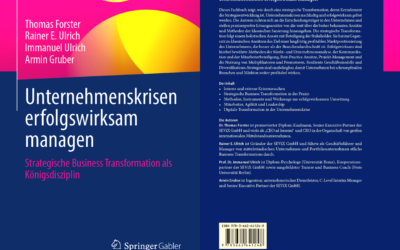In this first of two SEViX interviews, SEViX founder Rainer E. Ulrich and the Senior Executive Partner Dr. Thomas Forster on what is needed to bring about effective, sustainable changes in companies to overcome crises and which entrepreneurial profiles are required to achieve this.
Leading companies out of the current crisis using traditional instruments, such as classic turnaround management, which focuses on restructuring the liabilities side and the assets side, i.e., improving the performance economy, the balance sheet, is no longer effective in the current emerging corporate and industry crises. A strategic business transformation is indispensable.
The classic Chief Restructuring Officer (CRO) of the past cannot meet the new requirements of strategic business transformation. This requires a completely new requirements profile. A Chief Transformation Manager (CTO) with strategic competence, who ideally acts on an equal footing with the CEO, will fill this role in the future.
SEViX: I would like to welcome Dr. Thomas Forster and Rainer E. Ulrich to this interview. Today we will talk about strategic business transformations and a changed requirement profile of the classic CRO.
Dr. Forster, when you talk about a strategic transformation, what is different? What is new?
Dr. Forster: Strategic business transformation also draws on classic and familiar turnaround measures such as staff reductions, cutting loss-makers or streamlining the product and customer portfolio. However, it goes beyond the cost-cutting or efficiency-enhancing program of turnaround. The dedicated focus of business transformation is on strategy development and implementation. It focuses on sustainable, profitable sales growth above the industry average through continuous improvement measures along the entire value chain. In classic turnaround, the focus is on ensuring short- and medium-term economic viability through drastic cost reductions and earnings improvements.
SEViX: Would you add anything to that, Mr. Ulrich?
Ulrich: A focus on innovations in megatrend product areas that generate sustainable profitable growth should be added. Digitization and artificial intelligence are tools - not stand-alone strategies - for driving transformational change and innovation. I would also like to mention the fact of increasing corporate value through sustainable profitable revenue growth. Strategic business transformation relies on a holistic approach as opposed to short- and medium-term individual measures in traditional turnarounds.
Essentially, a company's own opportunities to act and shape its business can still exist in the case of business transformation as opposed to restructuring, which can essentially be determined by the creditors.
SEViX: Historically, many of these major transformation projects have failed. Mr. Ulrich, in your experience, why is that? What kind of patterns do we see?
Ulrich: First of all, I think executives are right to be skeptical about this term "transformation" and the opportunities it can offer. My findings and publications on this, show a consistently very high failure rate of these programs as reported by the companies themselves. About 70 percent or so is routinely cited as the likely failure rate of these types of programs. What I find is that the resistance - both the resistance in the broader workforce of a company and, frankly, in the extended management team itself - is often very high to making these kinds of changes. That's true for traditional turnarounds as well as strategic business transformations.
SEViX: Let's talk just a little bit about the classic CRO, the Chief Transformation Officer, who is a key success factor in a change process.
UlrichThe classic CRO must be entrusted with the functional authority - i.e., the executive body - to be able to implement changes. He manages the turnaround with a team of internal employees and possible external consultants and keeps the existing management free for the day-to-day business. The classic CRO is often essentially a cost manager who should quickly achieve breakeven through appropriate measures.
SEViX: What do you mean by a CTO, the Chief Transformation Manager, and how does it differ from a traditional CRO.
Dr. Forster: A modern business transformation manager or chief transformation officer can be expected to bring the company into a better strategic position through a successful strategy development process. Here we already have the central difference to the classic CRO. Without strong functional and personal authority, even the business transformation manager cannot be successfully effective in the company. It therefore makes sense to place the business transformation manager at the first management level if possible. The most conducive solution is to combine a temporary CEO role with the role of a business transformation manager, which can provide the necessary strongest functional authority for the change process. Without personal authority, however, the business transformation manager is always doomed to failure.
Ulrich: The Business Transformation Manager is largely responsible for locating the areas that need improvement within an organization. He or she must identify and implement necessary changes so that a company can act as best-in-class. The Business Transformation Manager has an entrepreneurial role and is crucially integrated into the corporate hierarchy. To develop a strategy, he or she needs a clear business analysis - strengths and weaknesses - and a definition of clear business objectives.
SEViX: can you add some more specific tasks and differences?
Ulrich: The Business Transformation Manager acts as a central point of contact between various departments within the company and relevant third parties. He develops and communicates strategies and goals with relevant departments and colleagues. He is a communicator and not a processor. He is also in charge of operations and ensures that the company continues to run operationally.
Dr. Forster: In contrast to the classic cost-driven CRO, the business transformation manager is a coach with high situational social and communication skills. A CRO in the classic sense will not be able to achieve this.
The Business Transformation Manager must bridge gaps between departments, is an interface manager, and must maintain open communication about all aspects of the business. All of this will help employees better understand the company and explain the reasons for restructuring or business transformation of the company. He must identify multipliers and promoters in the company and convince them to play a key role in the change process and empower them personally and professionally to do so - in short, to get people to act differently.
SEViX: You described the Business Transformation Manager as a coach - can you name a few more key personal characteristics?
Dr. Forster: I'll summarize some briefly: Sound experience and knowledge of strategy, general business processes, and organizational framework conditions such as goals, culture, and structure - better I would say: entrepreneurial anticipatory skills. A charismatic charisma with high personal authority is important to keep the necessary communication process going. Teamwork and leadership skills as well as motivation and passion are also required. Relationships must be built within and outside the company. Without one's own high level of innovation and creativity, it will be difficult to force the innovative power of a company.
Ulrich: I want to bring the essential differences to the point again: Since anticipatory skills are a MUST for the new type of business redeveloper, better the business transformation manager, JURISTS cannot fulfill this requirement profile
There is no doubt that there are few turnaround managers who demonstrate expertise and passion primarily in strategic transformation. Turnaround, operational transformation and performance management fall short, as does restructuring of the liabilities side. High social skills with personal authority are a MUST, something less emphasized in the past.
A determined communication policy and personal acceptance are essential success factors of any business transformation, and personal authority is indispensable for this.
SEViX: I'm afraid that's all we have time for today. Many thanks to Dr. Forster and Mr. Ulrich for taking the time to talk to us about "The classic CRO has no future".





0 Comments